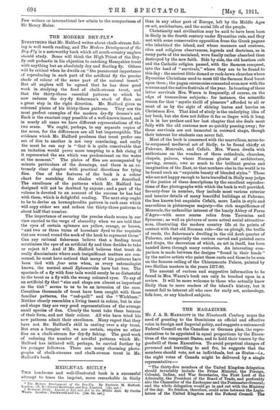THE MODERN DRY-FLY.•
EVERYTHING that Mr. Halford writes about chalk-stream fish- ing is well worth reading, and The Modern Development of the Dry-Fly is a noteworthy book which all south-country anglers
should study. Some will think the High Priest of the Dry- fly cult pedantic in his objection to catching Hampshire trout with anything but an absolutely dry and floating fly. Others will be critical when he dwells on " the paramount importance of reproducing in each part of the artificial fly the precise shade of colour of the same part of the natural insect." But all anglers will be agreed that he has done good work in studying the food of chalk-stream trout, and that the thirty-three essential patterns to which he now reduces the dry-fly fisherman's stock of flies are a great step in the right direction. Mr. Halford gives us coloured plates of his thirty-three patterns. They are the most perfect examples of the modern dry-fly dresser's art. Each is the exactest copy possible of a well-known insect, and in nearly all cases we have different representations of the two sexes. We ought, perhaps, to say separate copies of the sexes, for the differences are all but imperceptible. The evidence which Mr. Halford produces that trout prefer one sex of dun to another is not very convincing, and really the most he can say is " that it is quite conceivable that an imitation would prove more tempting to a fish rising if it represented the sex which was predominant on the water at the moment." The plates of flies are accompanied by minute particulars of the dressings, and there is an ex- tremely clear chapter with practical directions for tying flies. One of the features of the book is a colour chart for matching the shades which are described. The excellence of the patterns which Mr. Halford has designed will not be doubted by anyone ; and a part of the volume is devoted to an account of the success he has had with them, which is delightful reading. The next step ought to be to devise an hermaphrodite pattern in each case which will copy either sex and reduce the thirty-three patterns to about half that number.
The importance of securing the precise shade seems in our view carried to the verge of absurdity when we are told that the eyes of certain spinners are yellow, orange, or brown, " and two or three turns of horsehair dyed to the requisite tint are wound round the neck of the hook to represent these." Can any rational fisherman believe that a feeding trout scrutinises the eyes of an artificial fly and then decides to take or reject it ? And if Mr. Halford believes that trout do really discriminate where such insignificant matters are con- cerned, he must have noticed that many of his patterns have been tied with four sets when, as every entomologist knows, the normal small Epherneridm have but two. The spectacle of a fly with four tails would surely be as distasteful to the trout as a fly with the wrong coloured eyes. To say of an artificial fly that " size and shape are almost as important as the tint " seems to us to be an inversion of the case. Countless thousands of trout have been caught with those familiar patterns, the "red-quill" and the " Wickham." Neither closely resembles a living insect in colour, but in size and shape they are very good representations of the average small species of dun. Clearly the trout take them because of their form, and not their colour. All who have tried his new patterns admit their excellence. Many regret that they have not Mr. Halford's skill in casting over a shy trout. But even a bungler will, we are certain, require no other flies on a chalk-stream for dry-fly fishing. The good work of reducing the number of needful patterns which Mr. Halford has initiated will, perhaps, be carried further by his younger followers. There are many charming photo- graphs of chalk-streams and chalk-stream trout in Mr. Halford's book.










































 Previous page
Previous page